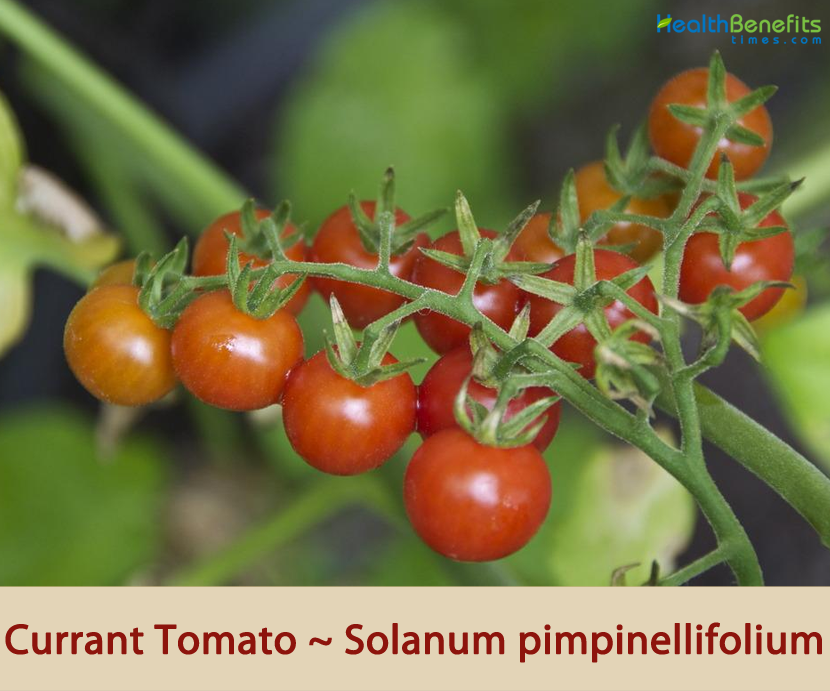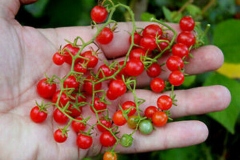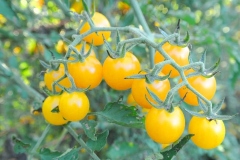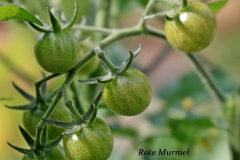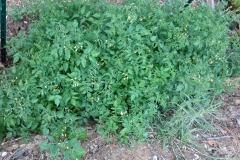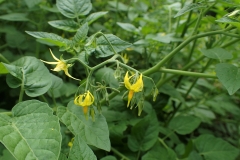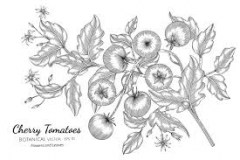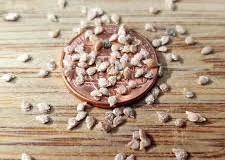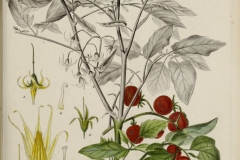The plant has been introduced as a crop into the Galapagos, where it has shown a tendency to invade disturbed areas. It is of particular concern there due to possible hybridization with native Solanaceae. It is often included in breeding programs intended to increase resistance and flavor of the common tomato. Its small fruits are edible, and it is commonly grown in gardens as an heirloom tomato, although it is considered to be wild rather than domesticated as is the commonly cultivated tomato species Solanum lycopersicum. Its genome was sequenced in 2012.
Currant Tomato Facts
| Currant Tomato Quick Facts | |
|---|---|
| Name: | Currant Tomato |
| Scientific Name: | Solanum pimpinellifolium |
| Origin | Ecuador, Chili and Coastal region Peru |
| Colors | Initially green turning to bright red as they mature |
| Shapes | Fruit is 1 cm in diameter, globose, 2-locular, bright red when ripe |
| Taste | Sweet and sour in taste with a hint of spiciness |
| Health benefits | Support for rheumatism, headaches, burns, scalds, sunburn, toothache and protect people from heart attacks. |
| Name | Currant Tomato |
|---|---|
| Scientific Name | Solanum pimpinellifolium |
| Native | Ecuador, Chili and Coastal region Peru but naturalized elsewhere, such as the Galápagos Islands |
| Common Names | German Raising Tomato, Tomatillo and Currant tomato |
| Name in Other Languages | Danish: Cherry-tomato English: German Raising Tomato, Tomatillo, Currant tomato German: Johannisbeertomate, Kirschtomate Japanese: Soranumu pinpineriforiumu (ソラヌム・ピンピネリフォリウム) Persian: گوجه انگورکی Spanish: Tomate cimarrón, tomate de campo, tomate silvestre, tomatillo Swedish: Vinbärstomat |
| Plant Growth Habit | Annual to biennial plant |
| Soil | Soil should be amended to be loose and fertile; rich with organic matter- several inches of compost worked in will do wonders! The looseness of the soil is for the roots, as hard, compact soil is hard for them to grow in |
| Plant Size | Grow about 1.5 meters high and one meter wide |
| Stem | Erect initially, later procumbent or decumbent, sparsely pubescent or nearly glabrous |
| Branches | Branches are slender and initially erect, becoming procumbent or decumbent |
| Leaf | Leaves interrupted impari-pinnate, 4-12 cm long, 1.5-8 cm wide, green, sparsely to densely pubescent with a mixture of uniseriate glandular and eglandular trichomes |
| Flower | Flowers with the calyx tube 0.05-0.1 mm long, the lobes are 0.25-0.5 cm long and 0.1-0.25 cm wide, lanceolate, densely pubescent with uniseriate trichomes like the rest of the inflorescence. Corolla is 1.2-3 cm in diameter, stellate, pale yellow to bright yellow, the tube 0.1-0.25 cm long, the free portion of the lobes are 1-1.5 cm long, 0.2-0.4 cm wide, the tips margins densely and minutely white pubescent abaxially |
| Fruit Shape & Size | Fruit is 1 cm in diameter, globose, 2-locular, bright red when ripe; sparsely to densely glandular pubescent with short uniseriate trichomes 0.5 mm long, with multicellular and unicellular heads |
| Fruit Color | Initially green turning to bright red as they mature |
| Fruit Weight | Just three grams |
| Taste | Sweet and sour in taste with a hint of spiciness |
Plant Description
Currant Tomato is an annual to biennial plant with slender branches that are erect initially, later becoming procumbent or decumbent. The plant normally grows about 1.5 meters high and one meter wide. For optimum growth the soil should be amended to be loose and fertile, rich with organic matter. Several inches of compost worked in will do wonders! The looseness of the soil is for the roots, as hard, compact soil is hard for them to grow in. Stem is erect initially, later procumbent or decumbent, sparsely pubescent or nearly glabrous.
Leaves
Leaves interrupted impari-pinnate, 4-12 cm long, 1.5-8 cm wide, green, sparsely to densely pubescent with a mixture of uniseriate glandular and eglandular trichomes, pubescence velvety, more abundant along the veins and abaxially, in northern Peruvian populations with robust patent uniseriate trichomes like those of the stems along the veins abaxially; primary leaflets 2-4 pairs, slightly decreasing in size towards the leaf base, elliptic to broadly elliptic to ovate to broadly ovate, the base cordate or occasionally truncate, oblique and extended basiscopically, the margins entire or round-crenate or slightly dentate in the proximal third, the apex is somewhat rounded or acute to acuminate; terminal leaflet is 2.5-5 cm long and 1-3.5 cm wide, the petiolule 0.5-2 cm long; while lateral leaflets (largest) are 1.5-3.5 cm long and 1-2 cm wide, the petiolule 0.5-0.7 cm long, with the base usually decurrent basiscopically; secondary leaflets and tertiary leaflets are absent.
Flower
Inflorescences 4-25 cm long, usually simple, occasionally once-branched, with 7-30 flowers, ebracteate, peduncle 2-3 (-5) cm long, pubescent like the stems but with more glandular trichomes with multicellular heads. Buds are 0.5-1.2 cm long, elongate conical, with the corolla more than 2/3 to 3/4 of the way exserted from the calyx just before anthesis.
Flowers with the calyx tube 0.05-0.1 mm long, the lobes are 0.25-0.5 cm long and 0.1-0.25 cm wide, lanceolate, densely pubescent with uniseriate trichomes like the rest of the inflorescence. Corolla is 1.2-3 cm in diameter, stellate, pale yellow to bright yellow, the tube 0.1-0.25 cm long, the free portion of the lobes are 1-1.5 cm long, 0.2-0.4 cm wide, the tips margins densely and minutely white pubescent abaxially, the lobes strongly reflexed at anthesis; staminal column is 0.7-1 cm long, straight, the filaments 0.5-1 mm long. Anthers are 0.5-0.7 cm long, the sterile apical appendage 0.3-0.4 cm long; ovary conical to globose, glabrous; style 0.7-1 cm long, ca. 0.5 mm in diameter, densely white pubescent in the basal 1/3, straight, included to usually exserted 0.5-1 mm from the staminal column; stigma capitate, green.
Fruit
Fruit is 1 cm in diameter, globose, 2-locular, bright red when ripe; sparsely to densely glandular pubescent with short uniseriate trichomes 0.5 mm long, with multicellular and unicellular heads during maturation, glabrous when mature. Fruiting pedicels are 1.5-2 cm long, straight or bent in towards the rachis at the articulation point. Calyx lobes in fruit are 1-1.2 cm long and 0.25-0.4 cm wide, strongly reflexed and parallel with the fruiting pedicel.
Seeds are 2-3 mm long, 1-2.3 mm wide and 0.5-0.8 mm thick, obovate, narrowly winged at the apex and acute at the base, pale brown, pubescent with hair-like outgrowths of the lateral testa cell walls, theseadpressed and giving a silky appearance to the surface or more often shaggy, narrowly winged (0.3-0.4 mm) at the apex and acute at the base.
Currant tomato varieties
As mentioned above, currant tomatoes come in two colors: red or yellow. Here are some of the best currant varieties!
Red currant tomatoes
The ‘Red Currant’ tomato is a classic among tiny tomato varieties. Its fruits weigh about three grams and ripen very early in the season. Even smaller varieties of red currant tomato include the ‘Hawaiian’ currant tomato, ‘Sweet Pea’ currant tomato and the slight but flavorful ‘Spoon’ tomato.
Yellow currant tomatoes
The ‘Golden Currant’ grows just as abundantly as red currant tomato varieties. From mid-July onward, the yellow currant plant will begin to produce a bounty of sunny and sweet fruits. Golden currant tomato plants are low-maintenance and easy to care for but do need plenty space to accommodate their wide growth. Another yellow currant tomato variety, ‘Gold Rush’, is characterized by its long vines that bear countless small orange tomatoes. In autumn, gold rush tomato plants ripen well in a sunny spot, like on a warm windowsill.
Traditional uses and benefits of Currant Tomato
- It is also used in the treatment of rheumatism and headaches.
- Pulped fruit is an extremely beneficial skin-wash for people with oily skin.
- Sliced fruits are a quick and easy first aid treatment for burns, scalds and sunburn.
- A decoction of the root is ingested in the treatment of toothache.
- The skin of tomato fruits is a good source of lycopine, a substance that has been shown to protect people from heart attacks.
- A homeopathic remedy is made from the plant.
Culinary Uses
- It can be eaten raw, cooked, or dried for later use.
- Sweet and delicious, it makes an excellent dessert fruit and is also used in savory dishes as a vegetable.
- Edible oil is obtained from the seed.
- The seed is small and it would be very fiddly to utilize.
- It is only viable to use the seed as a source of oil if large quantities of the plants are being grown for their fruits and the seed is not wanted.
Other Facts
- The seeds yield edible oil which can also be used in making soap.
- The strong aroma of this plant is said to repel insects from nearby plants.
- Semi-drying oil is obtained from the seed.
Precautions
- All green parts of the plant are poisonous.
- Unless there are specific entries with information on edible uses, it would be unwise to ingest any part of this plant.
- Whilst these alkaloids can make the plant useful in treating a range of medical conditions, they can also cause problems such as nausea, vomiting, salivation, drowsiness, abdominal pain, diarrhea, weakness and respiratory depression.
References:
https://www.itis.gov/servlet/SingleRpt/SingleRpt?search_topic=TSN&search_value=565528#null
http://www.hear.org/pier/species/solanum_pimpinellifolium.htm
https://pfaf.org/user/Plant.aspx?LatinName=Solanum+pimpinellifolium
https://gd.eppo.int/taxon/LYPPI
http://www.theplantlist.org/tpl1.1/record/tro-29603447
https://en.wikipedia.org/wiki/Solanum_pimpinellifolium
https://temperate.theferns.info/viewtropical.php?id=Solanum+pimpinellifolium
https://grinczech.vurv.cz/gringlobal/taxon/taxonomydetail.aspx?id=406496
https://indiabiodiversity.org/species/show/245056
https://www.cabi.org/isc/datasheet/31840
https://plants.usda.gov/home/plantProfile?symbol=SOPI7


